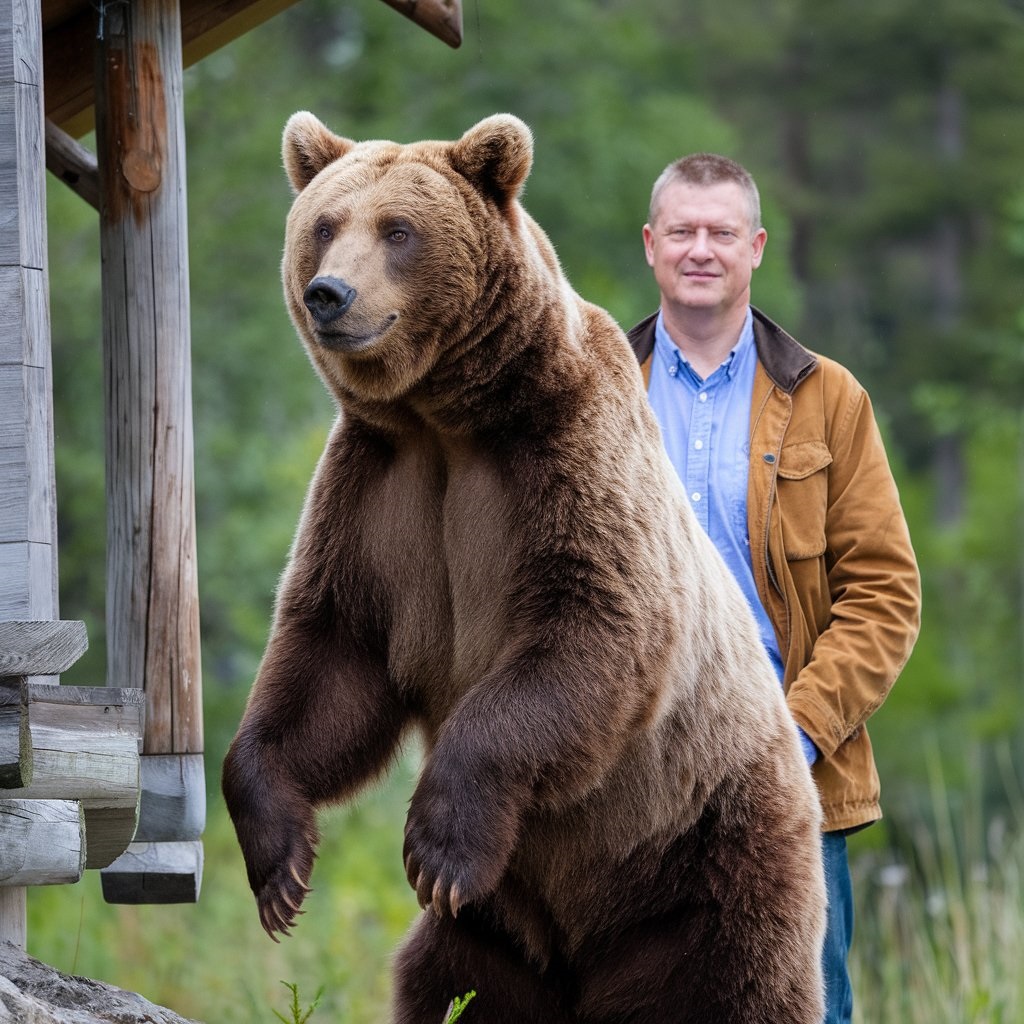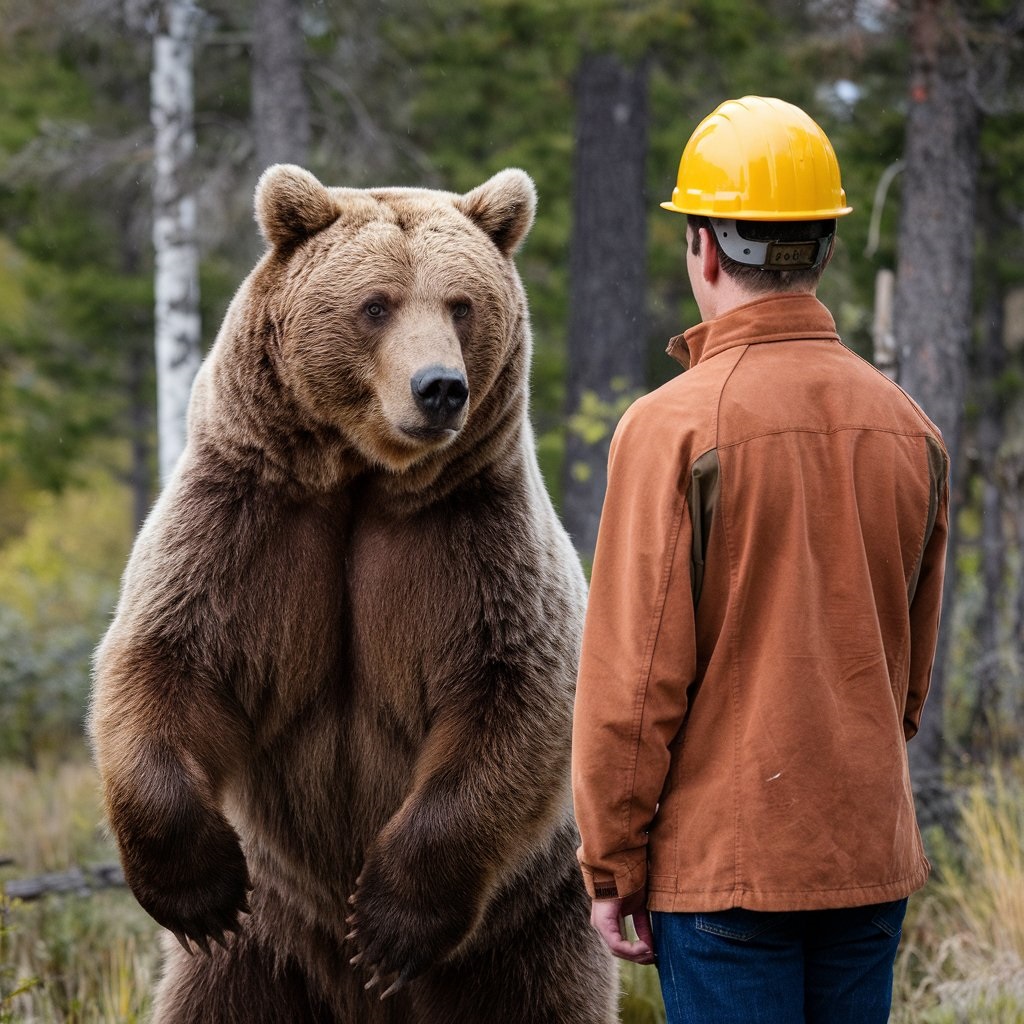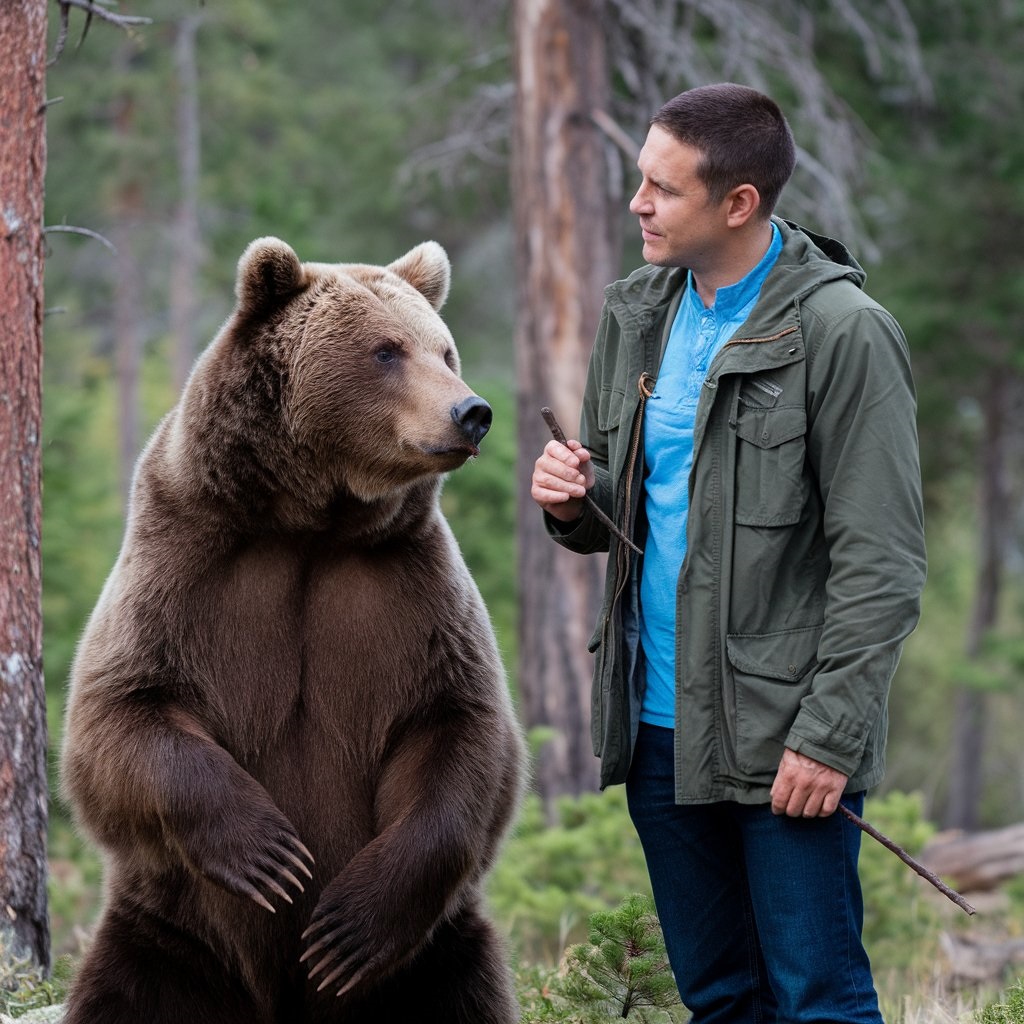Do Brown Bears Attack Humans? Brown bears (Ursus arctos) are among the most magnificent and awe-inspiring creatures in the wild. They are powerful, majestic, and capable of surviving in some of the harshest environments on Earth. However, these animals can also be dangerous, which often raises concerns among those who live near bear habitats or enjoy outdoor activities in places like Yellowstone National Park, Katmai National Park, and Denali National Park.
The question often arises: Do brown bears actually attack humans, or are these attacks rare events blown out of proportion by the media? In this comprehensive guide, we’ll delve deep into brown bear behavior, the circumstances behind their attacks, and the essential measures to avoid dangerous encounters.
Sure! Below is a table summarizing the key facts and figures from the article for easy reference:
| Fact/Statistic | Details |
|---|---|
| Scientific Name | Ursus arctos |
| Brown Bear Size | Males: 600-1,500 pounds; Females: 300-700 pounds; Up to 8 feet tall when on hind legs |
| Speed | Up to 30 miles per hour (in short bursts) |
| Typical Diet | Omnivorous: Berries, nuts, fish (salmon), small mammals, large mammals (e.g., moose, deer) |
| Primary Habitat Regions | Alaska, Western Canada, Russia, Scandinavia, Carpathian Mountains, Romania, Slovakia |
| Bear Attack Statistics (2000-2015) | 183 bear attacks in North America |
| Likelihood of Attack | Rare but potential risks from surprise encounters, cub protection, or food defense |
| Most Dangerous Attack Scenarios | Defensive attacks (especially protecting cubs or food) |
| Grizzly Bears vs Brown Bears | Grizzly bears are more aggressive towards humans, especially when protecting territory or cubs |
| Black Bears vs Brown Bears | Black bears are less likely to attack and more likely to flee compared to brown bears |
| Bear Spray Effectiveness | Reduces injury likelihood by up to 90% |
| Hiking and Camping Risks | Increased risk when hiking alone or when food is improperly stored in bear habitats |
| Most Active Bear Periods | Dawn and dusk, especially during spring and fall when foraging is critical |
| Bear Spray Usage | Keep within easy reach and know how to use it in case of an encounter |
| Common Injuries in Bear Attacks | Bites, lacerations, fractures, internal injuries |
| Survivability Factors | Bear spray, playing dead, and proper response can significantly increase survival chances |
| Food Storage Guidelines | Use bear-proof containers; never store food in tents or vehicles |
| Group Hiking | Traveling in groups reduces risk of a bear encounter |
| Proximity to Cubs | Mother bears with cubs are highly protective and more likely to attack |
What Are Brown Bears?
Before we dive into brown bear attacks, it’s essential to understand the animal itself.
The Brown Bear: An Overview
Brown bears, scientifically known as Ursus arctos, are one of the largest land carnivores. They have an extensive distribution across the Northern Hemisphere, with populations in regions like North America, Europe, and Russia. These animals are found in Alaska, Western Canada, and parts of Scandinavia. Brown bears can also be found in places like the Carpathian Mountains in Romania and Slovakia.

Characteristics of Brown Bears
- Size and Weight: Brown bears are massive, with adult males typically weighing between 600-1,500 pounds and standing at up to 8 feet tall when on their hind legs. Females are generally smaller but still formidable in size, averaging around 300-700 pounds. Despite their large size, brown bears are remarkably fast, capable of running up to 30 miles per hour in short bursts.
- Physical Features: They have broad, muscular shoulders and large paws equipped with sharp claws that help them dig and fish. Their fur is thick and can vary in color, from light brown to dark brown or even almost black, depending on the region they inhabit.
- Diet: Brown bears are omnivores, and their diet is diverse. They consume a mix of berries, nuts, plants, fish (especially salmon in coastal areas), and small mammals. In some regions, brown bears also hunt larger prey, such as moose or deer. Their diet changes seasonally, often based on what is available in their environment.
Behavior of Brown Bears
Brown bears are generally solitary animals. They only come together during mating season, or when a mother is with her cubs. During the spring and summer months, brown bears are usually busy foraging to build up fat reserves for hibernation during the winter months. They are typically more active during dawn and dusk, although some individuals may roam throughout the day or night.
Brown Bear Habitat
Brown bears are adaptable to a wide range of environments, from forests and mountainous areas to coastal regions. They can be found in areas such as Yellowstone National Park, Katmai National Park, Denali National Park, and even parts of Russia and Eastern Europe. These animals often prefer regions where they can easily access food sources such as rivers, lakes, or berry-rich landscapes. With their large home ranges, brown bears often come into conflict with humans when their habitats overlap with human activities like hiking, camping, or building settlements.
Brown Bear and Human Interaction
As human populations expand and people venture into the wilderness for recreation, interactions between humans and brown bears have become more frequent. Hiking, camping, and fishing are popular activities in bear territories. But what happens when a bear and a human cross paths?
Types of Human-Bear Encounters
Not all bear encounters are dangerous. In fact, most brown bears will avoid humans altogether. However, when humans venture into bear territories, they risk surprising a bear or encountering one that feels threatened. There are several types of interactions:
- Non-threatening Encounters: Bears may simply ignore humans if they don’t feel threatened, or they may act curious without aggression. These encounters usually end without any harm to the person or the bear.
- Defensive Encounters: These are the most common types of bear attacks. If a bear feels cornered, startled, or threatened, especially if it’s with its cubs or guarding food, it may become aggressive and charge at the human. Defensive attacks happen out of fear and the desire to protect its territory, cubs, or food sources.
- Predatory Encounters: These attacks are extremely rare but can occur in situations where the bear perceives a person as prey. This can happen if the bear is desperate due to food scarcity or has become habituated to human food. However, bears generally prefer to avoid humans and are not naturally inclined to hunt us.

The Fear of Brown Bear Attacks
The media often sensationalizes bear attacks, which leads to increased fear and misunderstanding about the true risks of encountering a brown bear. While bear attacks do occur, they are much less frequent than the stories make them seem.
Bear Attacks Statistics
Based on data collected from 2000 to 2015, there were 183 recorded bear attacks in North America, and not all of these were by brown bears. It’s important to note that the vast majority of these attacks were not fatal. While brown bears are capable of inflicting serious injuries, many of those who are attacked survive, especially if they carry bear deterrents or follow proper safety protocols.
Why Do Brown Bears Attack Humans?
Understanding why brown bears attack humans is crucial in reducing the risk of an encounter turning hostile. Brown bears are typically not aggressive toward humans unless provoked or threatened.
Defensive Behavior
Brown bears, particularly mothers with cubs, are highly protective. If a bear feels threatened—especially when it’s surprised or startled—it may react aggressively. Here are common causes for defensive attacks:
- Protecting Cubs: A mother bear is incredibly protective of her cubs. If a human gets too close to her young ones, the bear will not hesitate to attack.
- Surprise Encounters: Bears have poor eyesight, but they have an excellent sense of smell and hearing. If a bear is caught off guard, especially in dense foliage or when it’s not expecting human activity, it may react out of fear. This can lead to sudden attacks if the bear feels cornered.
- Food Defense: Bears are highly territorial and will defend food sources. If a human approaches a bear’s food stash, such as a carcass or a fishing spot, the bear may feel threatened and respond aggressively.
Predatory Behavior
While rare, predatory attacks can occur. These are usually driven by desperation or food scarcity. In cases where a bear has become habituated to human food or has been deprived of natural food sources, it may start to associate humans with food. However, predatory attacks are extremely uncommon compared to defensive encounters.
Risk Factors for Bear Attacks
Several factors contribute to the likelihood of a bear attack. By understanding these factors, we can take steps to minimize the risk of encountering a bear in a dangerous situation.
Proximity to Cubs
As mentioned earlier, mother bears with cubs are the most dangerous. Cubs are vulnerable, and a mother bear will do anything to protect them. If you encounter a bear with cubs, maintain a significant distance and avoid any actions that could cause the bear to feel threatened.
Human Behavior in Bear Territory
The way humans behave around bears can impact the likelihood of an attack. Common human mistakes include:
- Surprising the bear: Bears are easily startled. A sudden appearance of a human can cause a defensive reaction.
- Improper food storage: Bears are attracted to food. Improper storage of food, especially in campgrounds or hiking areas, can lead to bears associating humans with easy meals.
- Traveling alone: Bears tend to avoid groups. If you’re hiking alone, you may be at a higher risk of a bear encounter.

Environmental Factors
Bears are more active during certain seasons. Spring and early summer are particularly dangerous times for bear encounters, as bears emerge from hibernation and are hungry. Fall is another high-risk period, as bears prepare for hibernation and often forage aggressively.
How to Prevent a Brown Bear Attack
There are several strategies you can follow to reduce the chances of a bear attack while hiking, camping, or exploring bear habitats.
Bear Safety Tips
- Make Noise: Bears generally avoid humans if they hear them coming. Make noise by talking, clapping, or using bear bells to alert the bear to your presence.
- Travel in Groups: Bears are more likely to avoid groups of people. Hiking with others reduces the risk of a bear encounter turning dangerous.
- Carry Bear Spray: Bear spray is one of the most effective deterrents against a bear attack. Studies show that bear spray reduces the likelihood of injury by up to 90%. Always keep the spray within easy reach, and be sure you know how to use it.
- Store Food Properly: Food attracts bears. Use bear-proof containers and store food well away from your sleeping area. Never store food in tents or vehicles.
- Avoid Dawn and Dusk: Bears are most active during these times. To reduce the chances of an encounter, avoid outdoor activities at dawn and dusk when bears are more likely to be foraging.
How Dangerous Are Brown Bear Attacks?
While bear attacks are terrifying, they are relatively rare and typically avoidable with proper precautions. However, brown bear attacks can cause severe injuries due to the sheer size and strength of the animal. Bites and lacerations are the most common injuries, but fractured bones and internal injuries can also occur.
The risk of a fatal bear attack is low, but serious injuries can happen, particularly if proper precautions are not followed. The key is to stay vigilant, know the behaviors of brown bears, and be prepared to react correctly if an encounter occurs.
Comparing Brown Bears to Other Bears
Brown bears are often confused with other bear species, particularly grizzly bears and black bears. While all bears are potentially dangerous, there are key differences:
| Bear Species | Size | Aggression Level | Likelihood of Attack |
|---|---|---|---|
| Brown Bear | 600-1,500 pounds | High when threatened or hungry | Rare but potentially deadly |
| Grizzly Bear | 600-1,500 pounds | Very high when protecting cubs or food | More aggressive towards humans |
| Black Bear | 100-600 pounds | Generally less aggressive, more likely to flee | Less frequent than brown bear attacks |
FAQs
1. How likely is a brown bear to attack you?
Brown bear attacks are rare, usually happening when they feel threatened, such as when protecting cubs or food. Being prepared and staying calm can help avoid escalation.
2. Which bears don’t attack humans?
Brown bears typically avoid humans and don’t attack unless provoked. They are not naturally aggressive towards people.
3. What should you do if you see a brown bear?
Stay calm, speak in a calm voice to identify yourself, and slowly back away without running. Never approach the bear and avoid making sudden movements.
4. Which is more aggressive, black or brown bears?
Brown bears are generally more aggressive than black bears. If attacked, it’s advised to play dead, while with black bears, it’s better to fight back or seek shelter.
5. Can you fight off a brown bear?
In case of an attack, don’t play dead. Defend yourself by hitting the bear’s face with any available tools, like rocks or branches, but avoid fighting a grizzly bear if it charges.
6. Which bear attacks humans the most?
Grizzly bears cause the most human deaths, twice as many as black bears, despite their more remote habitats compared to polar bears.
7. Which bear is the deadliest?
Polar bears and grizzly bears are considered the deadliest, with brown bears also posing a significant risk to humans in certain circumstances.
8. Are brown bears friendly?
Brown bears are generally more aggressive than other species, like the American black bear, but they usually avoid humans unless provoked.
9. Should you look a brown bear in the eyes?
Avoid direct eye contact with a brown bear as it may see it as a challenge. Instead, slowly back away while making yourself appear larger.
10. Will a brown bear eat you if you lay down?
If you lay down with your face to the ground, the bear is likely to stop and not engage physically. It may just pass by without attacking.
11. What is a brown bear’s enemy?
Brown bears have no natural predators, with humans being their primary threat, often due to hunting or habitat destruction.

Final Verdict: Are Brown Bears Dangerous?
Brown bears can be dangerous, but attacks are rare. Most bear encounters happen without incident, and bear attacks typically occur when the animal feels threatened, particularly when it’s protecting cubs or food. By understanding bear behavior and following safety guidelines—like carrying bear spray, traveling in groups, and storing food properly—you can significantly reduce the risk of a dangerous encounter.
Key Takeaways:
- Brown bear attacks are rare, but they can happen if the bear feels threatened or surprised.
- Proper bear safety measures, such as carrying bear spray and avoiding dawn and dusk activities, can prevent most attacks.
- Respect for the bear’s territory and awareness of bear behavior are crucial for minimizing risks.
Understanding brown bears and their behavior is essential for anyone spending time in bear country. Stay informed, stay safe, and enjoy the wilderness responsibly.
Read more knowledgeable blogs on Flowy Magazine

James Clair is a passionate writer and researcher with a deep fascination for animal behavior and its intricate connection to human life. With a background in [relevant field of study, e.g., zoology, psychology, ethology], James has spent years studying the natural world, focusing on how animals’ actions and instincts impact human emotions, behavior, and society.
His expertise in [specific topics or regions of focus, e.g., canine psychology, animal communication, wildlife conservation] has led to numerous published works and collaborations with renowned researchers and institutions. Through his work at Flawy Magazine, James aims to bridge the gap between scientific research and public understanding, offering insightful, accessible articles that explore the complex relationship between humans and animals.
When he’s not writing, James enjoys [personal hobbies or interests, e.g., hiking in nature, volunteering at animal shelters, photography] and is an advocate for [cause or charity related to animals or conservation]. His mission is to inspire readers to see animals not just as companions or creatures of the wild, but as beings whose behavior holds valuable lessons for us all.









